Cambridge Satchel: HRM Practices Impact on Profitability & Growth
VerifiedAdded on 2024/06/03
|21
|4566
|216
Report
AI Summary
This report provides a comprehensive analysis of Human Resource Management (HRM) practices within an organizational context, focusing on Cambridge Satchel as a case study. It explores the purpose and functions of HRM in workforce planning and resourcing, evaluates the strengths and weaknesses of different recruitment and selection approaches, and explains the benefits of various HRM practices for both employers and employees. The report also assesses the effectiveness of HRM practices in enhancing organizational profit and productivity. Furthermore, it examines the importance of employee relations in influencing HRM decision-making and identifies key elements of employment legislation and their impact on HRM. The analysis includes practical examples of HRM practices applied in a work-related context, highlighting their significance in achieving organizational goals and maintaining a sustainable and productive work environment. This document is available on Desklib, where students can find a variety of solved assignments and study resources.
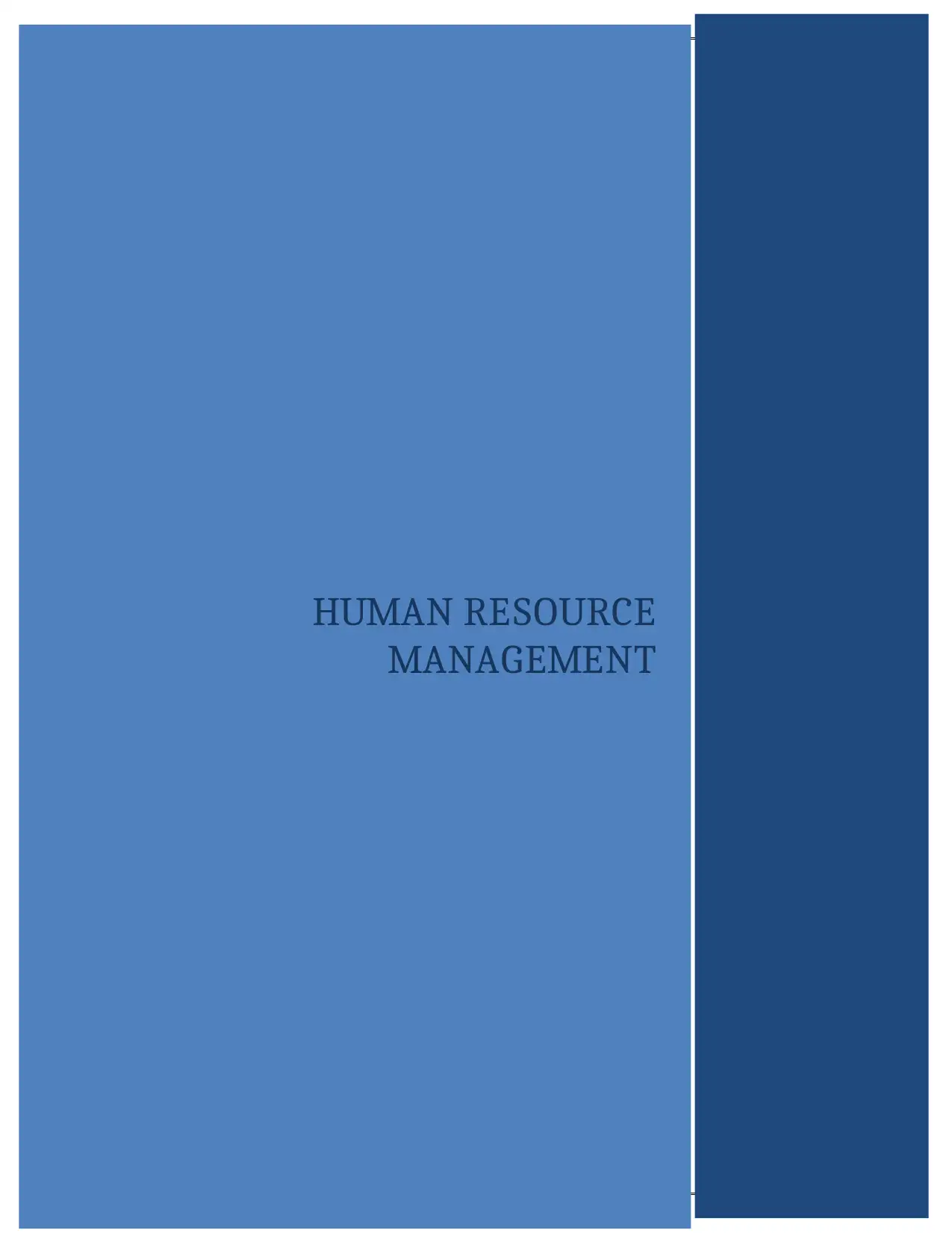
HUMAN RESOURCE
MANAGEMENT
MANAGEMENT
Paraphrase This Document
Need a fresh take? Get an instant paraphrase of this document with our AI Paraphraser
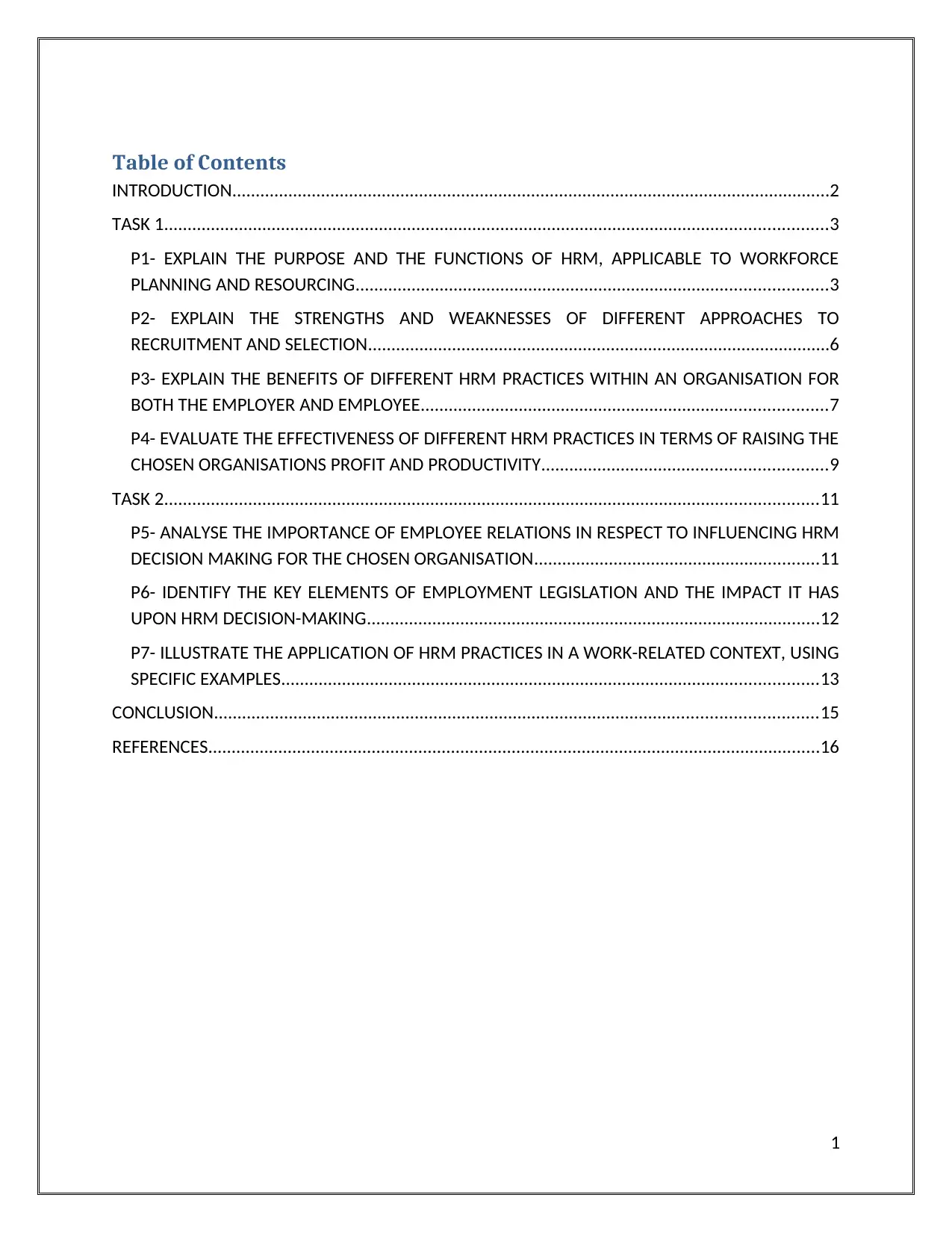
Table of Contents
INTRODUCTION................................................................................................................................2
TASK 1..............................................................................................................................................3
P1- EXPLAIN THE PURPOSE AND THE FUNCTIONS OF HRM, APPLICABLE TO WORKFORCE
PLANNING AND RESOURCING.....................................................................................................3
P2- EXPLAIN THE STRENGTHS AND WEAKNESSES OF DIFFERENT APPROACHES TO
RECRUITMENT AND SELECTION...................................................................................................6
P3- EXPLAIN THE BENEFITS OF DIFFERENT HRM PRACTICES WITHIN AN ORGANISATION FOR
BOTH THE EMPLOYER AND EMPLOYEE.......................................................................................7
P4- EVALUATE THE EFFECTIVENESS OF DIFFERENT HRM PRACTICES IN TERMS OF RAISING THE
CHOSEN ORGANISATIONS PROFIT AND PRODUCTIVITY.............................................................9
TASK 2............................................................................................................................................11
P5- ANALYSE THE IMPORTANCE OF EMPLOYEE RELATIONS IN RESPECT TO INFLUENCING HRM
DECISION MAKING FOR THE CHOSEN ORGANISATION.............................................................11
P6- IDENTIFY THE KEY ELEMENTS OF EMPLOYMENT LEGISLATION AND THE IMPACT IT HAS
UPON HRM DECISION-MAKING.................................................................................................12
P7- ILLUSTRATE THE APPLICATION OF HRM PRACTICES IN A WORK-RELATED CONTEXT, USING
SPECIFIC EXAMPLES...................................................................................................................13
CONCLUSION.................................................................................................................................15
REFERENCES...................................................................................................................................16
1
INTRODUCTION................................................................................................................................2
TASK 1..............................................................................................................................................3
P1- EXPLAIN THE PURPOSE AND THE FUNCTIONS OF HRM, APPLICABLE TO WORKFORCE
PLANNING AND RESOURCING.....................................................................................................3
P2- EXPLAIN THE STRENGTHS AND WEAKNESSES OF DIFFERENT APPROACHES TO
RECRUITMENT AND SELECTION...................................................................................................6
P3- EXPLAIN THE BENEFITS OF DIFFERENT HRM PRACTICES WITHIN AN ORGANISATION FOR
BOTH THE EMPLOYER AND EMPLOYEE.......................................................................................7
P4- EVALUATE THE EFFECTIVENESS OF DIFFERENT HRM PRACTICES IN TERMS OF RAISING THE
CHOSEN ORGANISATIONS PROFIT AND PRODUCTIVITY.............................................................9
TASK 2............................................................................................................................................11
P5- ANALYSE THE IMPORTANCE OF EMPLOYEE RELATIONS IN RESPECT TO INFLUENCING HRM
DECISION MAKING FOR THE CHOSEN ORGANISATION.............................................................11
P6- IDENTIFY THE KEY ELEMENTS OF EMPLOYMENT LEGISLATION AND THE IMPACT IT HAS
UPON HRM DECISION-MAKING.................................................................................................12
P7- ILLUSTRATE THE APPLICATION OF HRM PRACTICES IN A WORK-RELATED CONTEXT, USING
SPECIFIC EXAMPLES...................................................................................................................13
CONCLUSION.................................................................................................................................15
REFERENCES...................................................................................................................................16
1
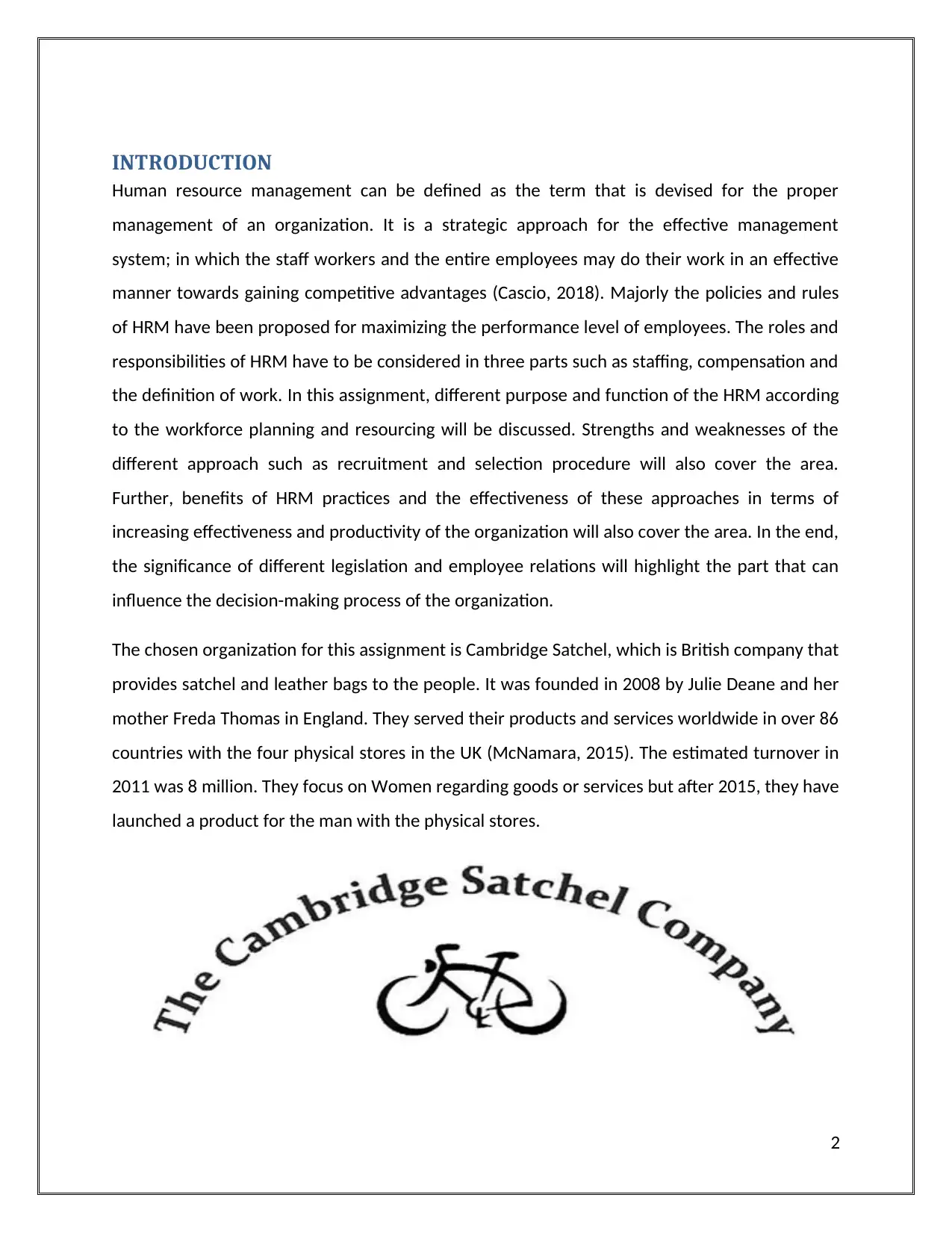
INTRODUCTION
Human resource management can be defined as the term that is devised for the proper
management of an organization. It is a strategic approach for the effective management
system; in which the staff workers and the entire employees may do their work in an effective
manner towards gaining competitive advantages (Cascio, 2018). Majorly the policies and rules
of HRM have been proposed for maximizing the performance level of employees. The roles and
responsibilities of HRM have to be considered in three parts such as staffing, compensation and
the definition of work. In this assignment, different purpose and function of the HRM according
to the workforce planning and resourcing will be discussed. Strengths and weaknesses of the
different approach such as recruitment and selection procedure will also cover the area.
Further, benefits of HRM practices and the effectiveness of these approaches in terms of
increasing effectiveness and productivity of the organization will also cover the area. In the end,
the significance of different legislation and employee relations will highlight the part that can
influence the decision-making process of the organization.
The chosen organization for this assignment is Cambridge Satchel, which is British company that
provides satchel and leather bags to the people. It was founded in 2008 by Julie Deane and her
mother Freda Thomas in England. They served their products and services worldwide in over 86
countries with the four physical stores in the UK (McNamara, 2015). The estimated turnover in
2011 was 8 million. They focus on Women regarding goods or services but after 2015, they have
launched a product for the man with the physical stores.
2
Human resource management can be defined as the term that is devised for the proper
management of an organization. It is a strategic approach for the effective management
system; in which the staff workers and the entire employees may do their work in an effective
manner towards gaining competitive advantages (Cascio, 2018). Majorly the policies and rules
of HRM have been proposed for maximizing the performance level of employees. The roles and
responsibilities of HRM have to be considered in three parts such as staffing, compensation and
the definition of work. In this assignment, different purpose and function of the HRM according
to the workforce planning and resourcing will be discussed. Strengths and weaknesses of the
different approach such as recruitment and selection procedure will also cover the area.
Further, benefits of HRM practices and the effectiveness of these approaches in terms of
increasing effectiveness and productivity of the organization will also cover the area. In the end,
the significance of different legislation and employee relations will highlight the part that can
influence the decision-making process of the organization.
The chosen organization for this assignment is Cambridge Satchel, which is British company that
provides satchel and leather bags to the people. It was founded in 2008 by Julie Deane and her
mother Freda Thomas in England. They served their products and services worldwide in over 86
countries with the four physical stores in the UK (McNamara, 2015). The estimated turnover in
2011 was 8 million. They focus on Women regarding goods or services but after 2015, they have
launched a product for the man with the physical stores.
2
⊘ This is a preview!⊘
Do you want full access?
Subscribe today to unlock all pages.

Trusted by 1+ million students worldwide
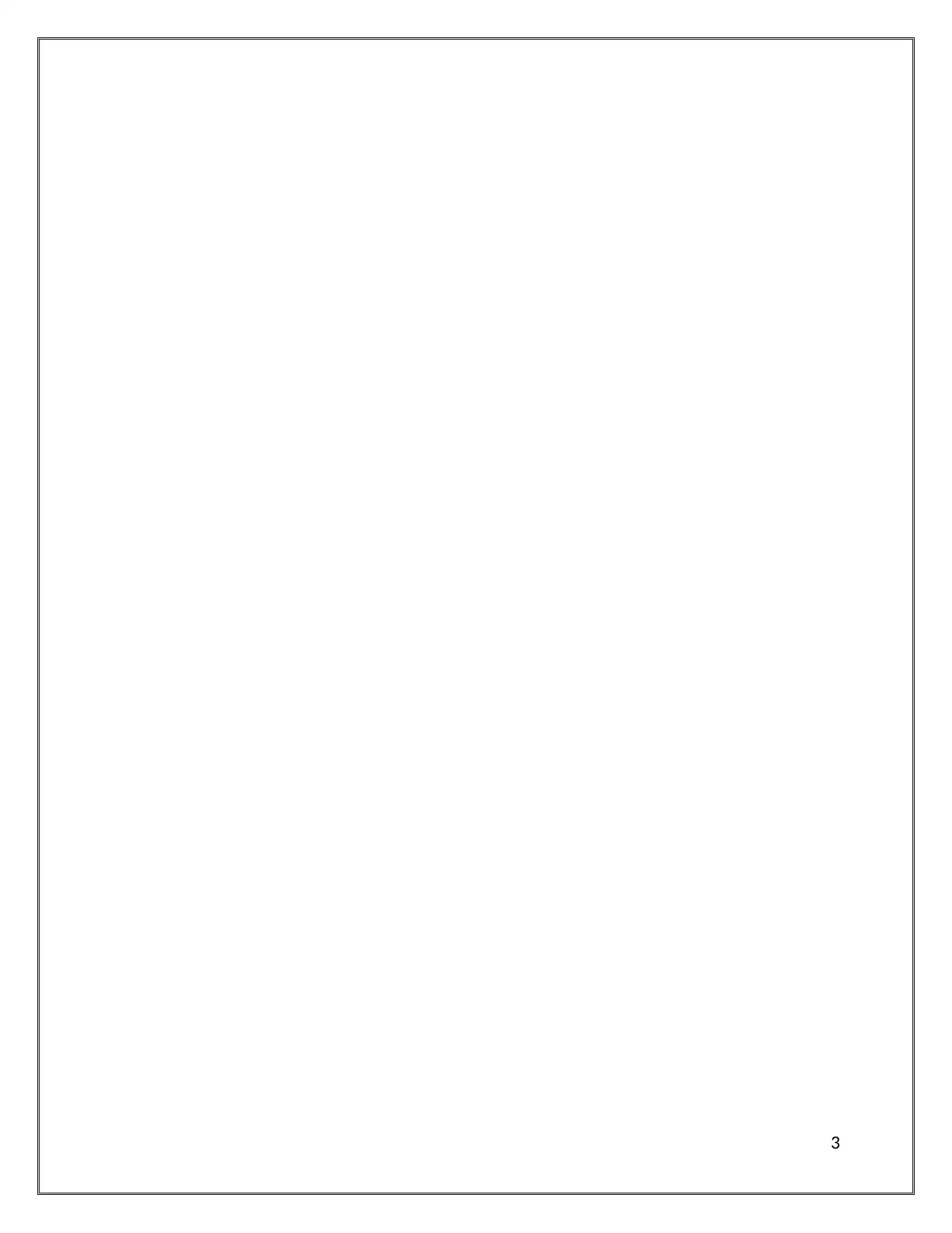
3
Paraphrase This Document
Need a fresh take? Get an instant paraphrase of this document with our AI Paraphraser
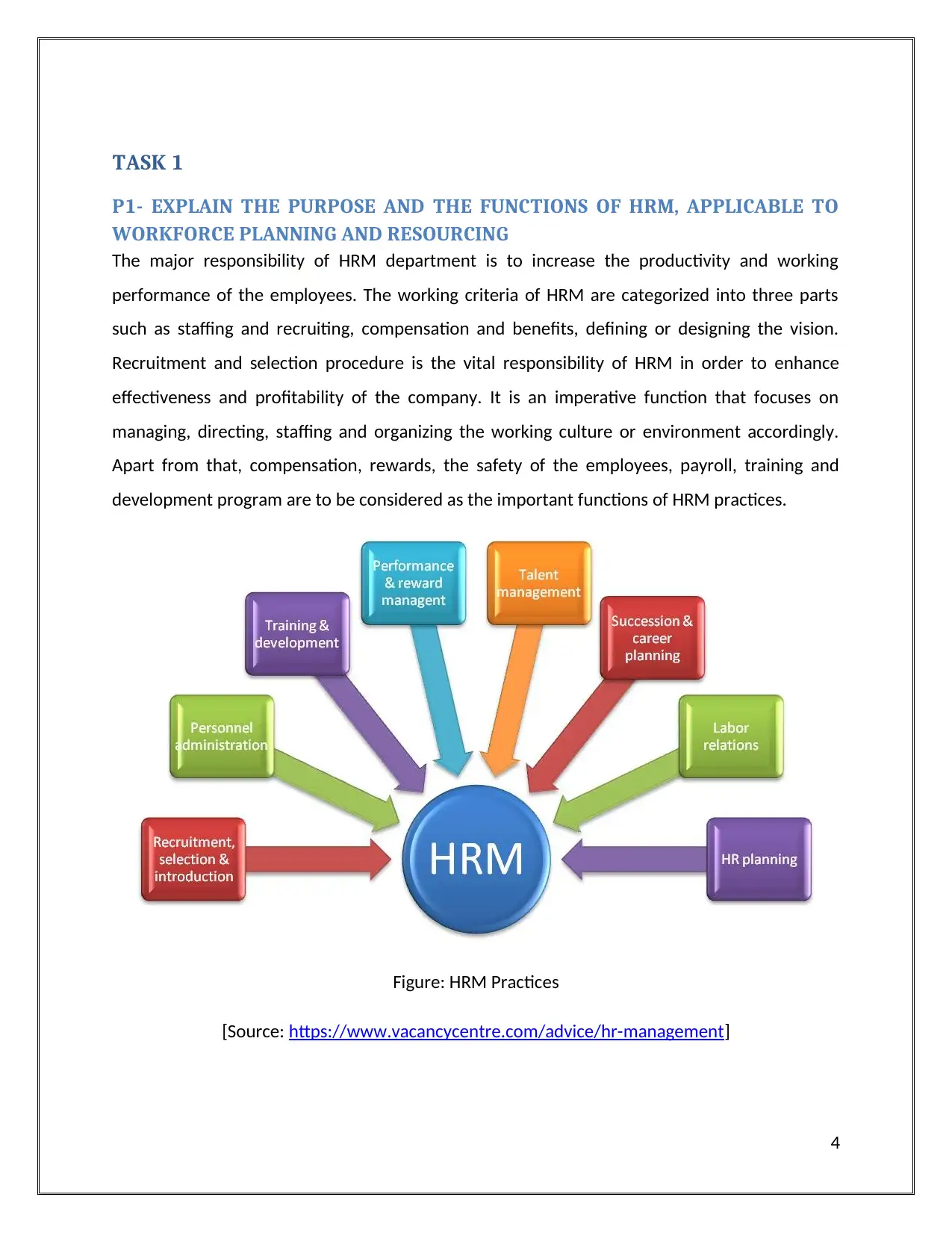
TASK 1
P1- EXPLAIN THE PURPOSE AND THE FUNCTIONS OF HRM, APPLICABLE TO
WORKFORCE PLANNING AND RESOURCING
The major responsibility of HRM department is to increase the productivity and working
performance of the employees. The working criteria of HRM are categorized into three parts
such as staffing and recruiting, compensation and benefits, defining or designing the vision.
Recruitment and selection procedure is the vital responsibility of HRM in order to enhance
effectiveness and profitability of the company. It is an imperative function that focuses on
managing, directing, staffing and organizing the working culture or environment accordingly.
Apart from that, compensation, rewards, the safety of the employees, payroll, training and
development program are to be considered as the important functions of HRM practices.
Figure: HRM Practices
[Source: https://www.vacancycentre.com/advice/hr-management]
4
P1- EXPLAIN THE PURPOSE AND THE FUNCTIONS OF HRM, APPLICABLE TO
WORKFORCE PLANNING AND RESOURCING
The major responsibility of HRM department is to increase the productivity and working
performance of the employees. The working criteria of HRM are categorized into three parts
such as staffing and recruiting, compensation and benefits, defining or designing the vision.
Recruitment and selection procedure is the vital responsibility of HRM in order to enhance
effectiveness and profitability of the company. It is an imperative function that focuses on
managing, directing, staffing and organizing the working culture or environment accordingly.
Apart from that, compensation, rewards, the safety of the employees, payroll, training and
development program are to be considered as the important functions of HRM practices.
Figure: HRM Practices
[Source: https://www.vacancycentre.com/advice/hr-management]
4
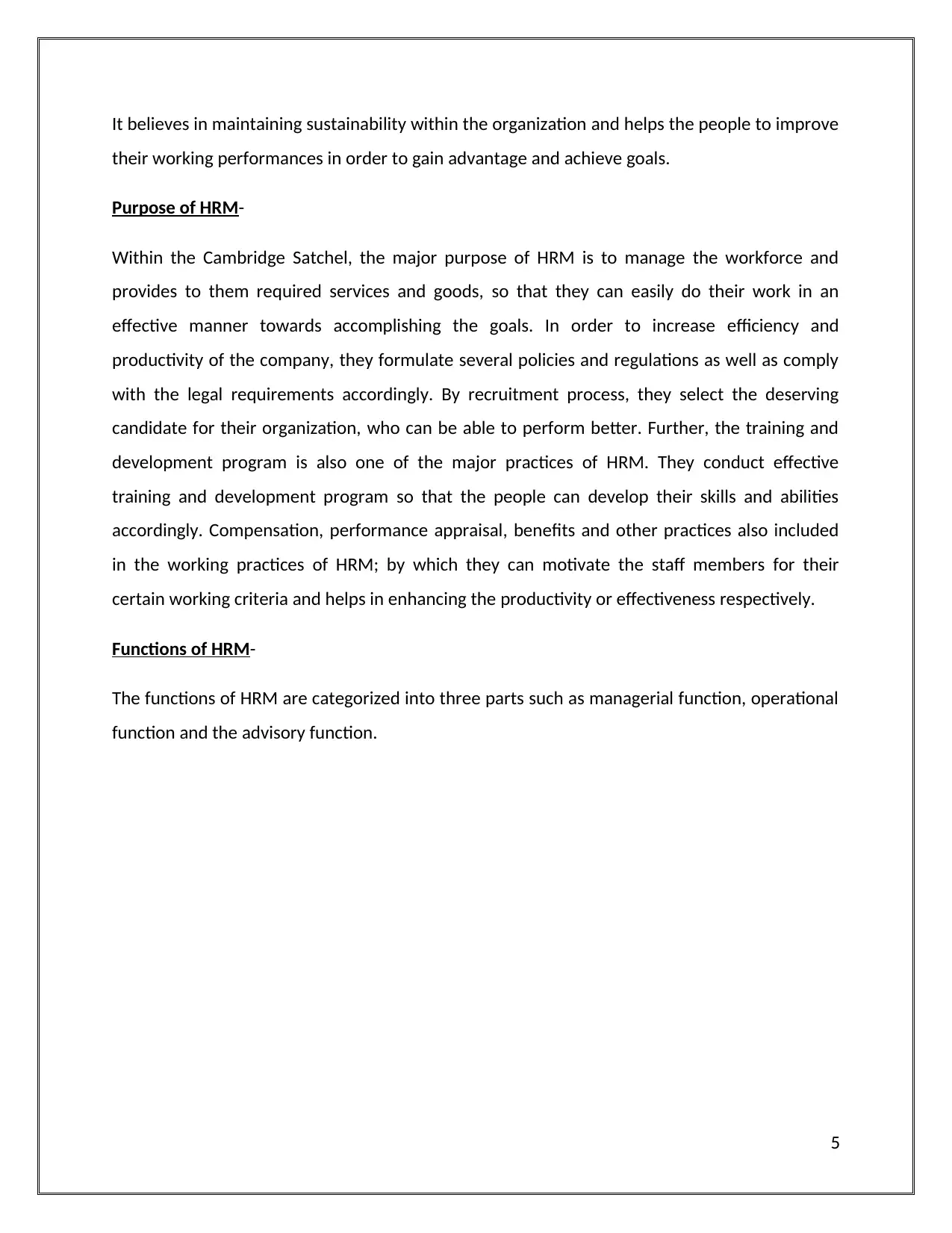
It believes in maintaining sustainability within the organization and helps the people to improve
their working performances in order to gain advantage and achieve goals.
Purpose of HRM-
Within the Cambridge Satchel, the major purpose of HRM is to manage the workforce and
provides to them required services and goods, so that they can easily do their work in an
effective manner towards accomplishing the goals. In order to increase efficiency and
productivity of the company, they formulate several policies and regulations as well as comply
with the legal requirements accordingly. By recruitment process, they select the deserving
candidate for their organization, who can be able to perform better. Further, the training and
development program is also one of the major practices of HRM. They conduct effective
training and development program so that the people can develop their skills and abilities
accordingly. Compensation, performance appraisal, benefits and other practices also included
in the working practices of HRM; by which they can motivate the staff members for their
certain working criteria and helps in enhancing the productivity or effectiveness respectively.
Functions of HRM-
The functions of HRM are categorized into three parts such as managerial function, operational
function and the advisory function.
5
their working performances in order to gain advantage and achieve goals.
Purpose of HRM-
Within the Cambridge Satchel, the major purpose of HRM is to manage the workforce and
provides to them required services and goods, so that they can easily do their work in an
effective manner towards accomplishing the goals. In order to increase efficiency and
productivity of the company, they formulate several policies and regulations as well as comply
with the legal requirements accordingly. By recruitment process, they select the deserving
candidate for their organization, who can be able to perform better. Further, the training and
development program is also one of the major practices of HRM. They conduct effective
training and development program so that the people can develop their skills and abilities
accordingly. Compensation, performance appraisal, benefits and other practices also included
in the working practices of HRM; by which they can motivate the staff members for their
certain working criteria and helps in enhancing the productivity or effectiveness respectively.
Functions of HRM-
The functions of HRM are categorized into three parts such as managerial function, operational
function and the advisory function.
5
⊘ This is a preview!⊘
Do you want full access?
Subscribe today to unlock all pages.

Trusted by 1+ million students worldwide
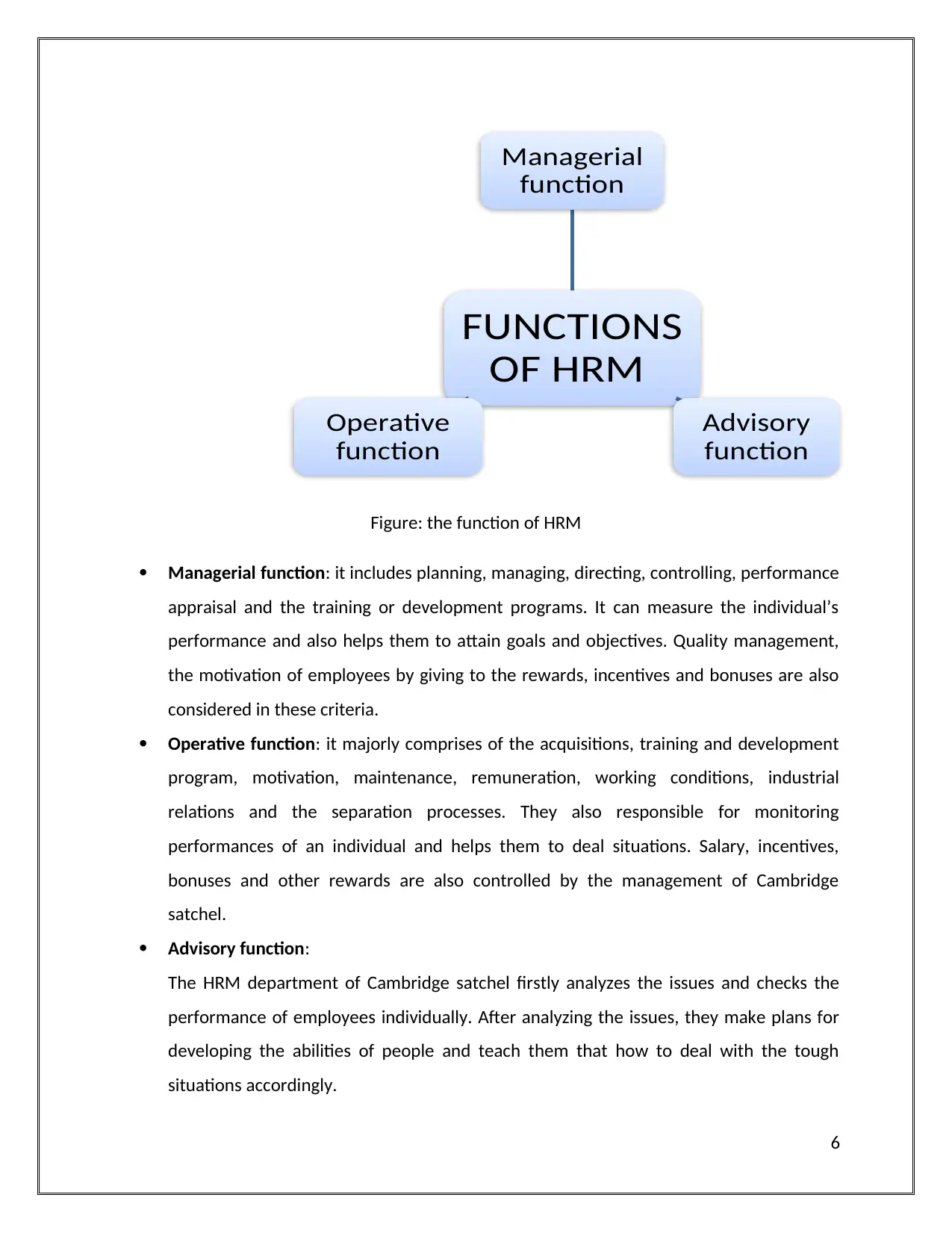
Figure: the function of HRM
Managerial function: it includes planning, managing, directing, controlling, performance
appraisal and the training or development programs. It can measure the individual’s
performance and also helps them to attain goals and objectives. Quality management,
the motivation of employees by giving to the rewards, incentives and bonuses are also
considered in these criteria.
Operative function: it majorly comprises of the acquisitions, training and development
program, motivation, maintenance, remuneration, working conditions, industrial
relations and the separation processes. They also responsible for monitoring
performances of an individual and helps them to deal situations. Salary, incentives,
bonuses and other rewards are also controlled by the management of Cambridge
satchel.
Advisory function:
The HRM department of Cambridge satchel firstly analyzes the issues and checks the
performance of employees individually. After analyzing the issues, they make plans for
developing the abilities of people and teach them that how to deal with the tough
situations accordingly.
6
FUNCTIONS
OF HRM
Managerial
function
Advisory
function
Operative
function
Managerial function: it includes planning, managing, directing, controlling, performance
appraisal and the training or development programs. It can measure the individual’s
performance and also helps them to attain goals and objectives. Quality management,
the motivation of employees by giving to the rewards, incentives and bonuses are also
considered in these criteria.
Operative function: it majorly comprises of the acquisitions, training and development
program, motivation, maintenance, remuneration, working conditions, industrial
relations and the separation processes. They also responsible for monitoring
performances of an individual and helps them to deal situations. Salary, incentives,
bonuses and other rewards are also controlled by the management of Cambridge
satchel.
Advisory function:
The HRM department of Cambridge satchel firstly analyzes the issues and checks the
performance of employees individually. After analyzing the issues, they make plans for
developing the abilities of people and teach them that how to deal with the tough
situations accordingly.
6
FUNCTIONS
OF HRM
Managerial
function
Advisory
function
Operative
function
Paraphrase This Document
Need a fresh take? Get an instant paraphrase of this document with our AI Paraphraser
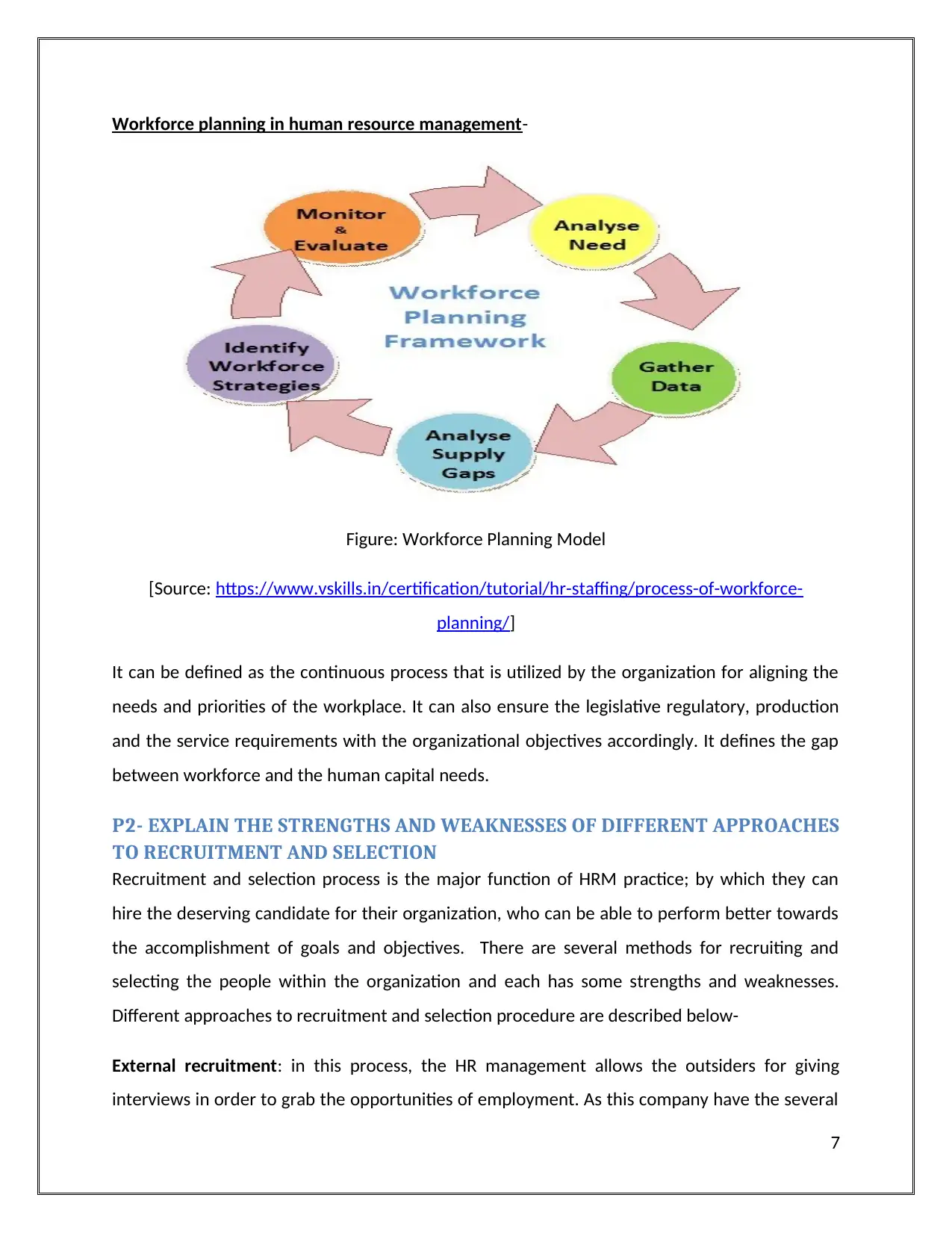
Workforce planning in human resource management-
Figure: Workforce Planning Model
[Source: https://www.vskills.in/certification/tutorial/hr-staffing/process-of-workforce-
planning/]
It can be defined as the continuous process that is utilized by the organization for aligning the
needs and priorities of the workplace. It can also ensure the legislative regulatory, production
and the service requirements with the organizational objectives accordingly. It defines the gap
between workforce and the human capital needs.
P2- EXPLAIN THE STRENGTHS AND WEAKNESSES OF DIFFERENT APPROACHES
TO RECRUITMENT AND SELECTION
Recruitment and selection process is the major function of HRM practice; by which they can
hire the deserving candidate for their organization, who can be able to perform better towards
the accomplishment of goals and objectives. There are several methods for recruiting and
selecting the people within the organization and each has some strengths and weaknesses.
Different approaches to recruitment and selection procedure are described below-
External recruitment: in this process, the HR management allows the outsiders for giving
interviews in order to grab the opportunities of employment. As this company have the several
7
Figure: Workforce Planning Model
[Source: https://www.vskills.in/certification/tutorial/hr-staffing/process-of-workforce-
planning/]
It can be defined as the continuous process that is utilized by the organization for aligning the
needs and priorities of the workplace. It can also ensure the legislative regulatory, production
and the service requirements with the organizational objectives accordingly. It defines the gap
between workforce and the human capital needs.
P2- EXPLAIN THE STRENGTHS AND WEAKNESSES OF DIFFERENT APPROACHES
TO RECRUITMENT AND SELECTION
Recruitment and selection process is the major function of HRM practice; by which they can
hire the deserving candidate for their organization, who can be able to perform better towards
the accomplishment of goals and objectives. There are several methods for recruiting and
selecting the people within the organization and each has some strengths and weaknesses.
Different approaches to recruitment and selection procedure are described below-
External recruitment: in this process, the HR management allows the outsiders for giving
interviews in order to grab the opportunities of employment. As this company have the several
7
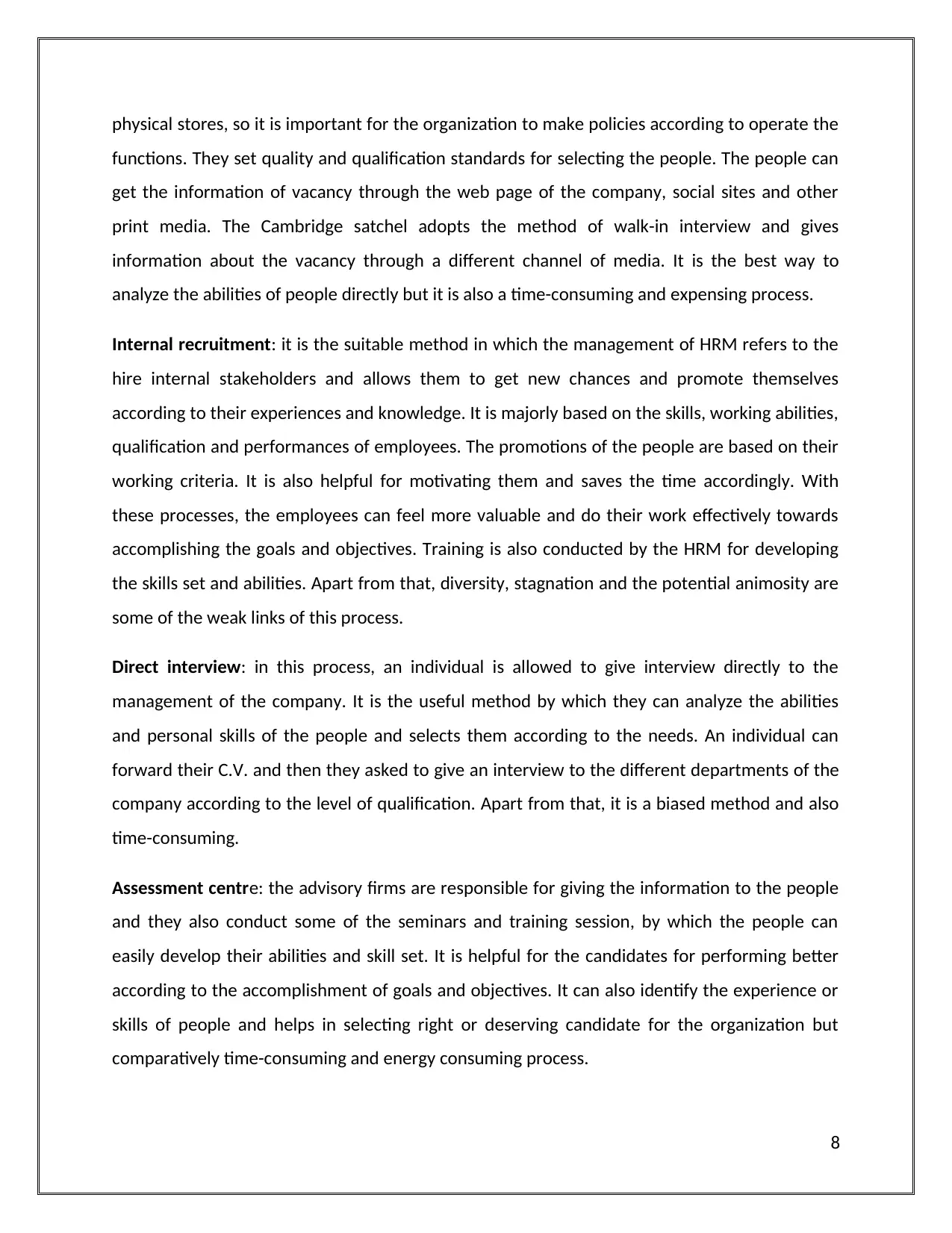
physical stores, so it is important for the organization to make policies according to operate the
functions. They set quality and qualification standards for selecting the people. The people can
get the information of vacancy through the web page of the company, social sites and other
print media. The Cambridge satchel adopts the method of walk-in interview and gives
information about the vacancy through a different channel of media. It is the best way to
analyze the abilities of people directly but it is also a time-consuming and expensing process.
Internal recruitment: it is the suitable method in which the management of HRM refers to the
hire internal stakeholders and allows them to get new chances and promote themselves
according to their experiences and knowledge. It is majorly based on the skills, working abilities,
qualification and performances of employees. The promotions of the people are based on their
working criteria. It is also helpful for motivating them and saves the time accordingly. With
these processes, the employees can feel more valuable and do their work effectively towards
accomplishing the goals and objectives. Training is also conducted by the HRM for developing
the skills set and abilities. Apart from that, diversity, stagnation and the potential animosity are
some of the weak links of this process.
Direct interview: in this process, an individual is allowed to give interview directly to the
management of the company. It is the useful method by which they can analyze the abilities
and personal skills of the people and selects them according to the needs. An individual can
forward their C.V. and then they asked to give an interview to the different departments of the
company according to the level of qualification. Apart from that, it is a biased method and also
time-consuming.
Assessment centre: the advisory firms are responsible for giving the information to the people
and they also conduct some of the seminars and training session, by which the people can
easily develop their abilities and skill set. It is helpful for the candidates for performing better
according to the accomplishment of goals and objectives. It can also identify the experience or
skills of people and helps in selecting right or deserving candidate for the organization but
comparatively time-consuming and energy consuming process.
8
functions. They set quality and qualification standards for selecting the people. The people can
get the information of vacancy through the web page of the company, social sites and other
print media. The Cambridge satchel adopts the method of walk-in interview and gives
information about the vacancy through a different channel of media. It is the best way to
analyze the abilities of people directly but it is also a time-consuming and expensing process.
Internal recruitment: it is the suitable method in which the management of HRM refers to the
hire internal stakeholders and allows them to get new chances and promote themselves
according to their experiences and knowledge. It is majorly based on the skills, working abilities,
qualification and performances of employees. The promotions of the people are based on their
working criteria. It is also helpful for motivating them and saves the time accordingly. With
these processes, the employees can feel more valuable and do their work effectively towards
accomplishing the goals and objectives. Training is also conducted by the HRM for developing
the skills set and abilities. Apart from that, diversity, stagnation and the potential animosity are
some of the weak links of this process.
Direct interview: in this process, an individual is allowed to give interview directly to the
management of the company. It is the useful method by which they can analyze the abilities
and personal skills of the people and selects them according to the needs. An individual can
forward their C.V. and then they asked to give an interview to the different departments of the
company according to the level of qualification. Apart from that, it is a biased method and also
time-consuming.
Assessment centre: the advisory firms are responsible for giving the information to the people
and they also conduct some of the seminars and training session, by which the people can
easily develop their abilities and skill set. It is helpful for the candidates for performing better
according to the accomplishment of goals and objectives. It can also identify the experience or
skills of people and helps in selecting right or deserving candidate for the organization but
comparatively time-consuming and energy consuming process.
8
⊘ This is a preview!⊘
Do you want full access?
Subscribe today to unlock all pages.

Trusted by 1+ million students worldwide
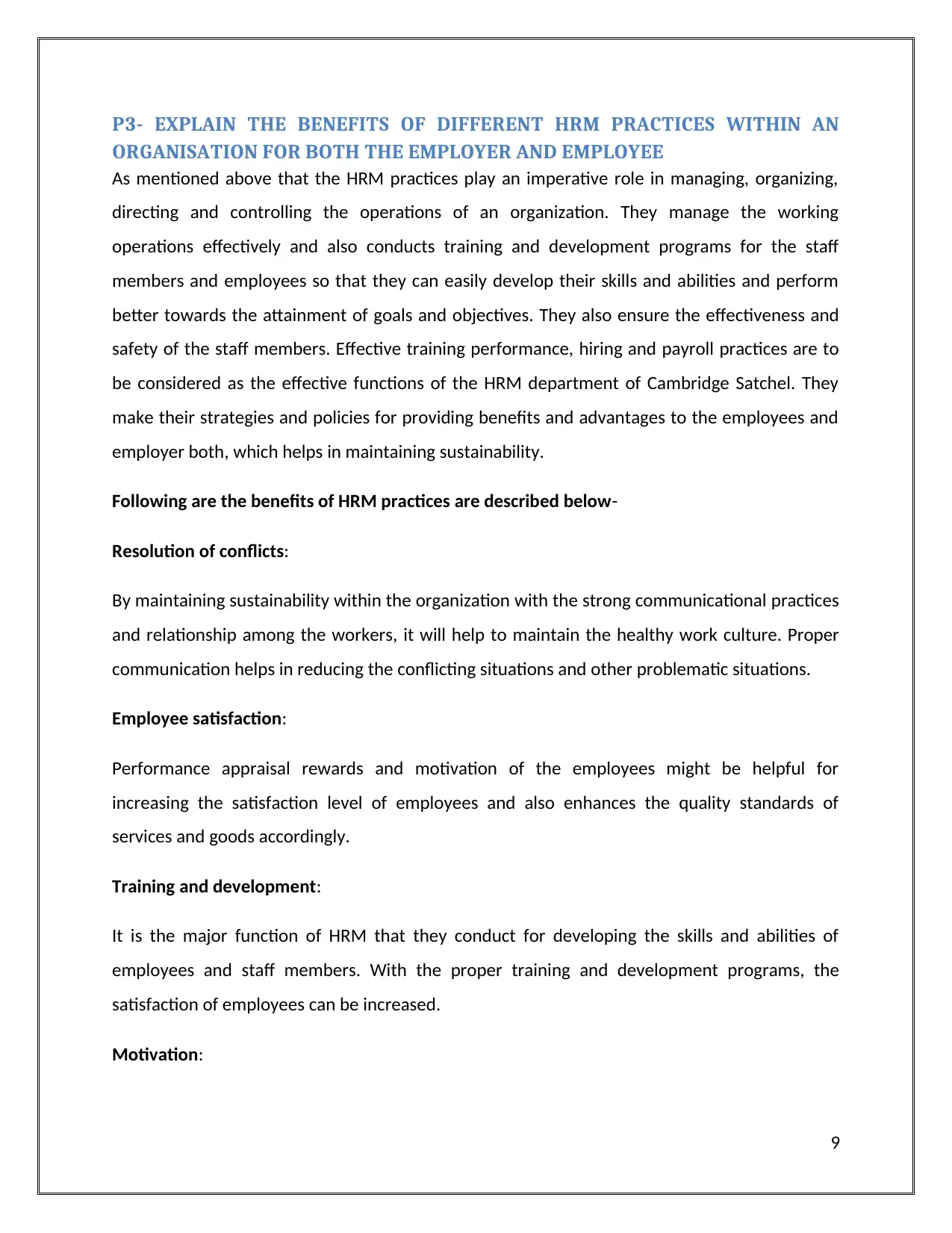
P3- EXPLAIN THE BENEFITS OF DIFFERENT HRM PRACTICES WITHIN AN
ORGANISATION FOR BOTH THE EMPLOYER AND EMPLOYEE
As mentioned above that the HRM practices play an imperative role in managing, organizing,
directing and controlling the operations of an organization. They manage the working
operations effectively and also conducts training and development programs for the staff
members and employees so that they can easily develop their skills and abilities and perform
better towards the attainment of goals and objectives. They also ensure the effectiveness and
safety of the staff members. Effective training performance, hiring and payroll practices are to
be considered as the effective functions of the HRM department of Cambridge Satchel. They
make their strategies and policies for providing benefits and advantages to the employees and
employer both, which helps in maintaining sustainability.
Following are the benefits of HRM practices are described below-
Resolution of conflicts:
By maintaining sustainability within the organization with the strong communicational practices
and relationship among the workers, it will help to maintain the healthy work culture. Proper
communication helps in reducing the conflicting situations and other problematic situations.
Employee satisfaction:
Performance appraisal rewards and motivation of the employees might be helpful for
increasing the satisfaction level of employees and also enhances the quality standards of
services and goods accordingly.
Training and development:
It is the major function of HRM that they conduct for developing the skills and abilities of
employees and staff members. With the proper training and development programs, the
satisfaction of employees can be increased.
Motivation:
9
ORGANISATION FOR BOTH THE EMPLOYER AND EMPLOYEE
As mentioned above that the HRM practices play an imperative role in managing, organizing,
directing and controlling the operations of an organization. They manage the working
operations effectively and also conducts training and development programs for the staff
members and employees so that they can easily develop their skills and abilities and perform
better towards the attainment of goals and objectives. They also ensure the effectiveness and
safety of the staff members. Effective training performance, hiring and payroll practices are to
be considered as the effective functions of the HRM department of Cambridge Satchel. They
make their strategies and policies for providing benefits and advantages to the employees and
employer both, which helps in maintaining sustainability.
Following are the benefits of HRM practices are described below-
Resolution of conflicts:
By maintaining sustainability within the organization with the strong communicational practices
and relationship among the workers, it will help to maintain the healthy work culture. Proper
communication helps in reducing the conflicting situations and other problematic situations.
Employee satisfaction:
Performance appraisal rewards and motivation of the employees might be helpful for
increasing the satisfaction level of employees and also enhances the quality standards of
services and goods accordingly.
Training and development:
It is the major function of HRM that they conduct for developing the skills and abilities of
employees and staff members. With the proper training and development programs, the
satisfaction of employees can be increased.
Motivation:
9
Paraphrase This Document
Need a fresh take? Get an instant paraphrase of this document with our AI Paraphraser
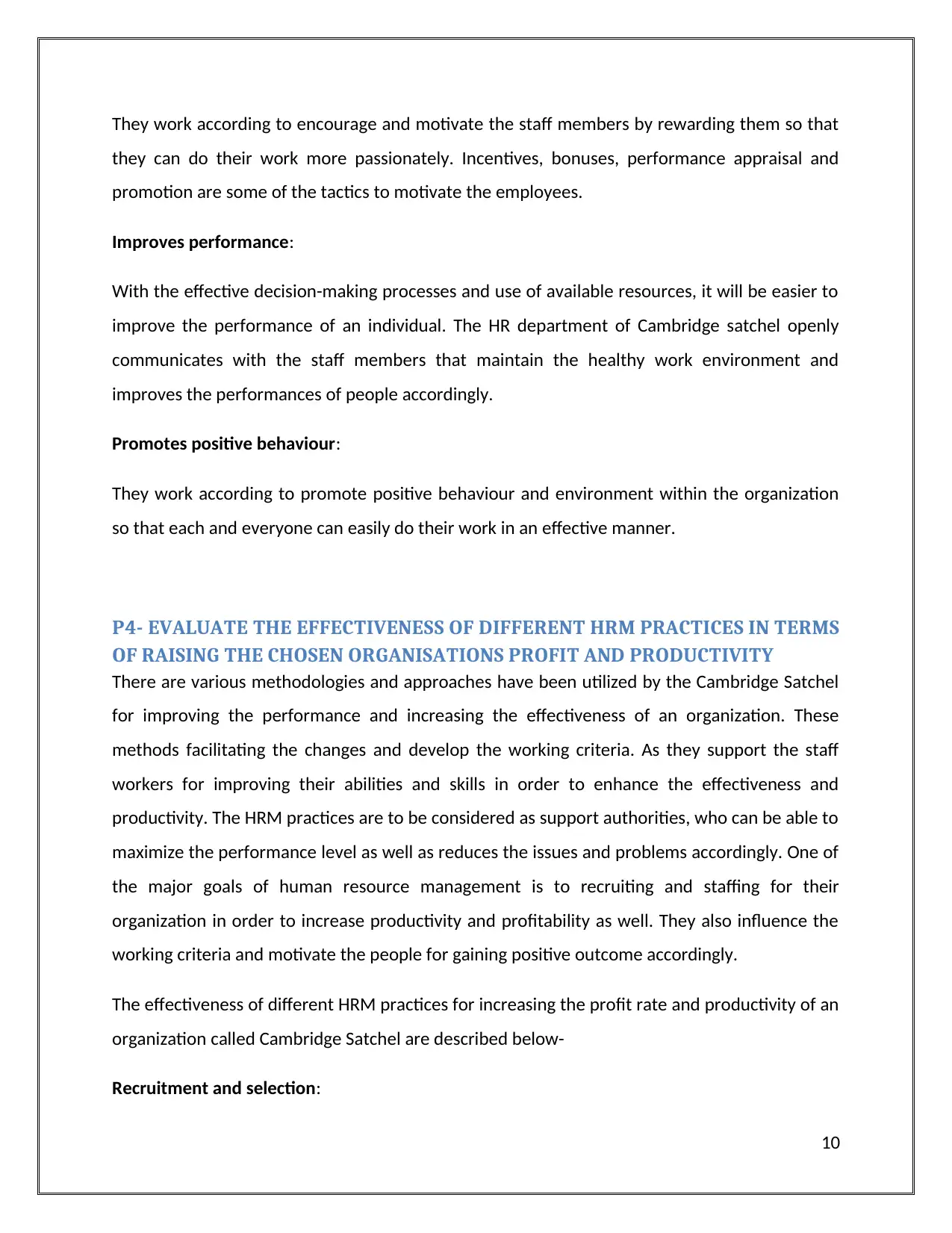
They work according to encourage and motivate the staff members by rewarding them so that
they can do their work more passionately. Incentives, bonuses, performance appraisal and
promotion are some of the tactics to motivate the employees.
Improves performance:
With the effective decision-making processes and use of available resources, it will be easier to
improve the performance of an individual. The HR department of Cambridge satchel openly
communicates with the staff members that maintain the healthy work environment and
improves the performances of people accordingly.
Promotes positive behaviour:
They work according to promote positive behaviour and environment within the organization
so that each and everyone can easily do their work in an effective manner.
P4- EVALUATE THE EFFECTIVENESS OF DIFFERENT HRM PRACTICES IN TERMS
OF RAISING THE CHOSEN ORGANISATIONS PROFIT AND PRODUCTIVITY
There are various methodologies and approaches have been utilized by the Cambridge Satchel
for improving the performance and increasing the effectiveness of an organization. These
methods facilitating the changes and develop the working criteria. As they support the staff
workers for improving their abilities and skills in order to enhance the effectiveness and
productivity. The HRM practices are to be considered as support authorities, who can be able to
maximize the performance level as well as reduces the issues and problems accordingly. One of
the major goals of human resource management is to recruiting and staffing for their
organization in order to increase productivity and profitability as well. They also influence the
working criteria and motivate the people for gaining positive outcome accordingly.
The effectiveness of different HRM practices for increasing the profit rate and productivity of an
organization called Cambridge Satchel are described below-
Recruitment and selection:
10
they can do their work more passionately. Incentives, bonuses, performance appraisal and
promotion are some of the tactics to motivate the employees.
Improves performance:
With the effective decision-making processes and use of available resources, it will be easier to
improve the performance of an individual. The HR department of Cambridge satchel openly
communicates with the staff members that maintain the healthy work environment and
improves the performances of people accordingly.
Promotes positive behaviour:
They work according to promote positive behaviour and environment within the organization
so that each and everyone can easily do their work in an effective manner.
P4- EVALUATE THE EFFECTIVENESS OF DIFFERENT HRM PRACTICES IN TERMS
OF RAISING THE CHOSEN ORGANISATIONS PROFIT AND PRODUCTIVITY
There are various methodologies and approaches have been utilized by the Cambridge Satchel
for improving the performance and increasing the effectiveness of an organization. These
methods facilitating the changes and develop the working criteria. As they support the staff
workers for improving their abilities and skills in order to enhance the effectiveness and
productivity. The HRM practices are to be considered as support authorities, who can be able to
maximize the performance level as well as reduces the issues and problems accordingly. One of
the major goals of human resource management is to recruiting and staffing for their
organization in order to increase productivity and profitability as well. They also influence the
working criteria and motivate the people for gaining positive outcome accordingly.
The effectiveness of different HRM practices for increasing the profit rate and productivity of an
organization called Cambridge Satchel are described below-
Recruitment and selection:
10
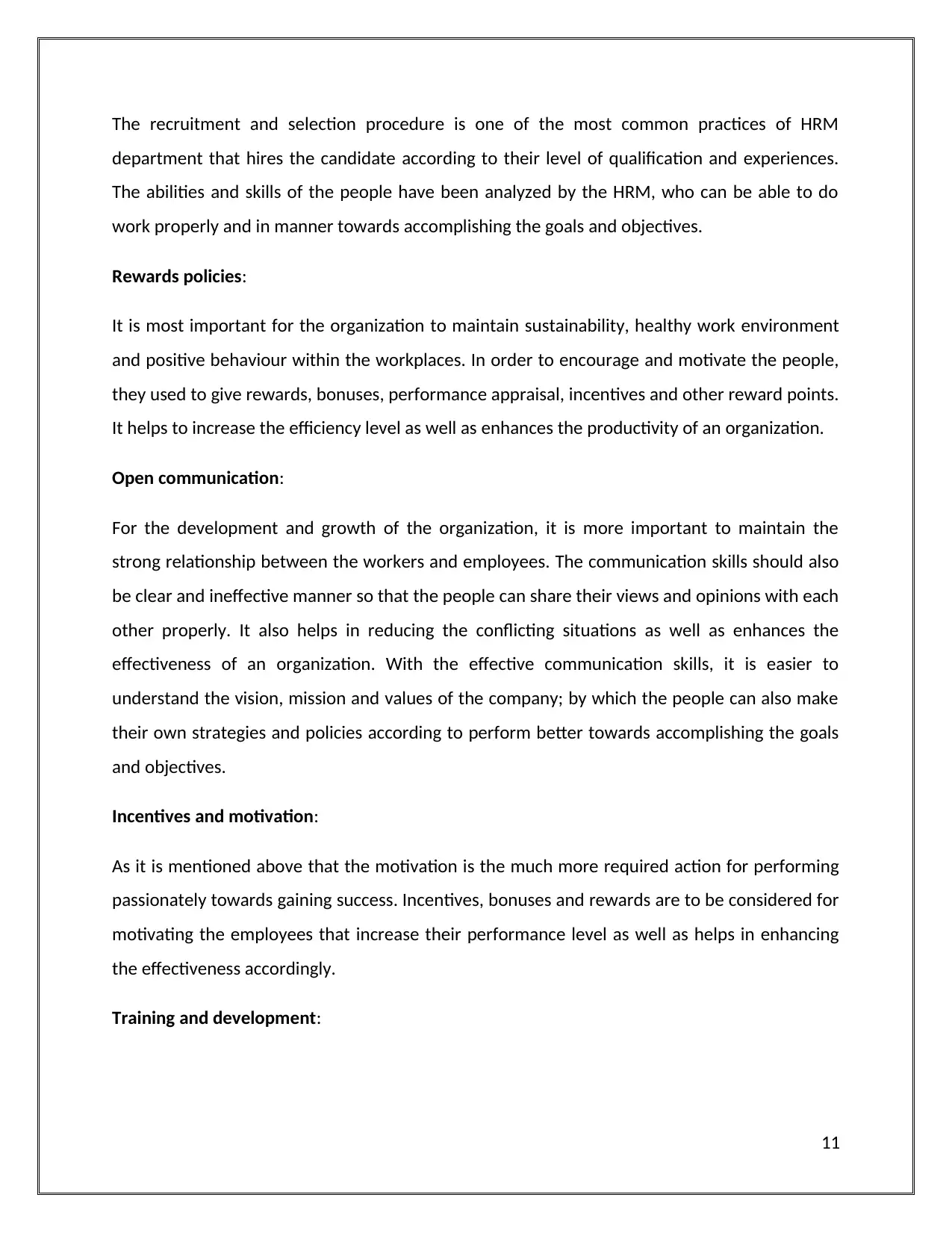
The recruitment and selection procedure is one of the most common practices of HRM
department that hires the candidate according to their level of qualification and experiences.
The abilities and skills of the people have been analyzed by the HRM, who can be able to do
work properly and in manner towards accomplishing the goals and objectives.
Rewards policies:
It is most important for the organization to maintain sustainability, healthy work environment
and positive behaviour within the workplaces. In order to encourage and motivate the people,
they used to give rewards, bonuses, performance appraisal, incentives and other reward points.
It helps to increase the efficiency level as well as enhances the productivity of an organization.
Open communication:
For the development and growth of the organization, it is more important to maintain the
strong relationship between the workers and employees. The communication skills should also
be clear and ineffective manner so that the people can share their views and opinions with each
other properly. It also helps in reducing the conflicting situations as well as enhances the
effectiveness of an organization. With the effective communication skills, it is easier to
understand the vision, mission and values of the company; by which the people can also make
their own strategies and policies according to perform better towards accomplishing the goals
and objectives.
Incentives and motivation:
As it is mentioned above that the motivation is the much more required action for performing
passionately towards gaining success. Incentives, bonuses and rewards are to be considered for
motivating the employees that increase their performance level as well as helps in enhancing
the effectiveness accordingly.
Training and development:
11
department that hires the candidate according to their level of qualification and experiences.
The abilities and skills of the people have been analyzed by the HRM, who can be able to do
work properly and in manner towards accomplishing the goals and objectives.
Rewards policies:
It is most important for the organization to maintain sustainability, healthy work environment
and positive behaviour within the workplaces. In order to encourage and motivate the people,
they used to give rewards, bonuses, performance appraisal, incentives and other reward points.
It helps to increase the efficiency level as well as enhances the productivity of an organization.
Open communication:
For the development and growth of the organization, it is more important to maintain the
strong relationship between the workers and employees. The communication skills should also
be clear and ineffective manner so that the people can share their views and opinions with each
other properly. It also helps in reducing the conflicting situations as well as enhances the
effectiveness of an organization. With the effective communication skills, it is easier to
understand the vision, mission and values of the company; by which the people can also make
their own strategies and policies according to perform better towards accomplishing the goals
and objectives.
Incentives and motivation:
As it is mentioned above that the motivation is the much more required action for performing
passionately towards gaining success. Incentives, bonuses and rewards are to be considered for
motivating the employees that increase their performance level as well as helps in enhancing
the effectiveness accordingly.
Training and development:
11
⊘ This is a preview!⊘
Do you want full access?
Subscribe today to unlock all pages.

Trusted by 1+ million students worldwide
1 out of 21
Related Documents
Your All-in-One AI-Powered Toolkit for Academic Success.
+13062052269
info@desklib.com
Available 24*7 on WhatsApp / Email
![[object Object]](/_next/static/media/star-bottom.7253800d.svg)
Unlock your academic potential
Copyright © 2020–2025 A2Z Services. All Rights Reserved. Developed and managed by ZUCOL.





